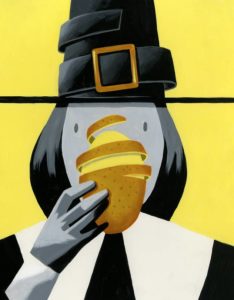Historically Speaking: How Potatoes Conquered the World
It took centuries for the spud to travel from the New World to the Old and back again
The Wall Street Journal, November 15, 2018

At the first Thanksgiving dinner, eaten by the Wampanoag Indians and the Pilgrims in 1621, the menu was rather different from what’s served today. For one thing, the pumpkin was roasted, not made into a pie. And there definitely wasn’t a side dish of mashed potatoes.
In fact, the first hundred Thanksgivings were spud-free, since potatoes weren’t grown in North America until 1719, when Scotch-Irish settlers began planting them in New Hampshire. Mashed potatoes were an even later invention. The first recorded recipe for the dish appeared in 1747, in Hannah Glasse’s splendidly titled “The Art of Cookery Made Plain and Easy, Which Far Exceeds Any Thing of the Kind yet Published.”
By then, the potato had been known in Europe for a full two centuries. It was first introduced by the Spanish conquerors of Peru, where the Incas had revered the potato and even invented a natural way of freeze-drying it for storage. Nevertheless, despite its nutritional value and ease of growing, the potato didn’t catch on in Europe. It wasn’t merely foreign and ugly-looking; to wheat-growing farmers it seemed unnatural—possibly even un-Christian, since there is no mention of the potato in the Bible. Outside of Spain, it was generally grown for animal feed.
The change in the potato’s fortunes was largely due to the efforts of a Frenchman named Antoine-Augustin Parmentier (1737-1813). During the Seven Years’ War, he was taken prisoner by the Prussians and forced to live on a diet of potatoes. To his surprise, he stayed relatively healthy. Convinced he had found a solution to famine, Parmentier dedicated his life after the war to popularizing the potato’s nutritional benefits. He even persuaded Marie-Antoinette to wear potato flowers in her hair.
Among the converts to his message were the economist Adam Smith, who realized the potato’s economic potential as a staple food for workers, and Thomas Jefferson, then the U.S. Ambassador to France, who was keen for his new nation to eat well in all senses of the word. Jefferson is credited with introducing Americans to french fries at a White House dinner in 1802.
As Smith predicted, the potato became the fuel for the Industrial Revolution. A study published in 2011 by Nathan Nunn and Nancy Qian in the Quarterly Journal of Economics estimates that up to a quarter of the world’s population growth from 1700 to 1900 can be attributed solely to the introduction of the potato. As Louisa May Alcott observed in “Little Men,” in 1871, “Money is the root of all evil, and yet it is such a useful root that we cannot get on without it any more than we can without potatoes.”
In 1887, two Americans, Jacob Fitzgerald and William H. Silver, patented the first potato ricer, which forced a cooked potato through a cast iron sieve, ending the scourge of lumpy mash. Still, the holy grail of “quick and easy” mashed potatoes remained elusive until the late 1950s. Using the flakes produced by the potato ricer and a new freeze drying method, U.S. government scientists perfected instant mashed potatoes, which only requires the simple step of adding hot water or milk to the mix. The days of peeling, boiling and mashing were now optional, and for millions of cooks, Thanksgiving became a little easier. And that’s something to be thankful for.
